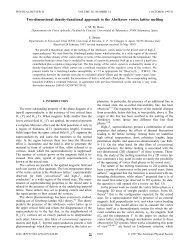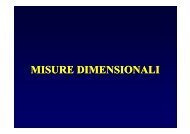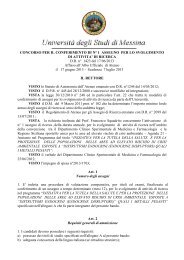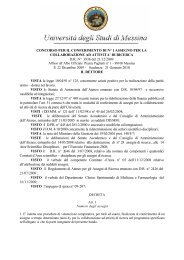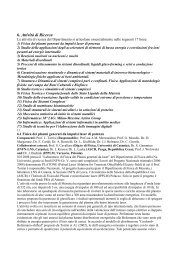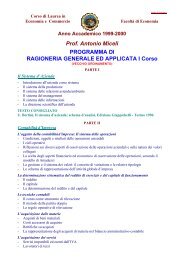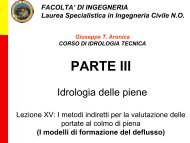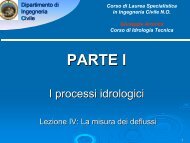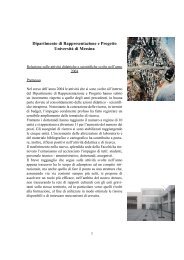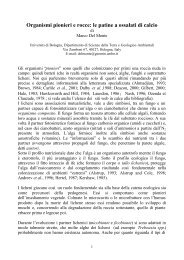PROGRAMME AND ABSTRACTS - Università degli Studi di Messina
PROGRAMME AND ABSTRACTS - Università degli Studi di Messina
PROGRAMME AND ABSTRACTS - Università degli Studi di Messina
You also want an ePaper? Increase the reach of your titles
YUMPU automatically turns print PDFs into web optimized ePapers that Google loves.
109<br />
these dangers is a dead who, through his wrath and phobos, evokes a demon which menaces<br />
the guilty and everyone hampers his thirst for revenge. The other one is a murderer who is, at<br />
the same time, victim of the obsessive memory of the felt and caused terror and of the provoked<br />
violence. This murderer experiences the lussa and the oblivion of his own identity. He is<br />
threatened by someone else’s revenge lust and anger and is dominated by a miasma which can<br />
infect everyone who is close to him. As a consequence, the terrific power of alastor consists of<br />
the impossibility to forget and embo<strong>di</strong>es frightful dangers of the failed oblivion. These<br />
dangers, as well as the norms created to embank them, have a religious origin, but they also<br />
express social and political issues especially in the Archaic and Classical Age. The extreme<br />
deformation generated by the violence makes the norms mentioned essential instruments used<br />
by every culture to think and to preserve itself both collectively and in<strong>di</strong>vidually.<br />
Luther H. Martin, University of Vermont, USA<br />
The Mithraic Diaspora and the Continuity of Cult Identity, Second-Fourth Century A.D.<br />
Given the entropic nature of information in transmission, the <strong>di</strong>spersion of any social group<br />
raises the question of their trans-geographical and trans-generational identity. Especially given<br />
the dynamics of the dramatically increased commercial, political and social mobility and<br />
interchange during the early centuries of our era, we might question whether any widespread<br />
identity among cults claiming a common name had any historical basis beyond certain<br />
superficial features or whether such an identity is the imaginative construction of modern<br />
historians based on those ostensibly identifying features? A de<strong>di</strong>catory inscription for a<br />
mithraeum on the Greek island of Andros instantiates the spread Mithraic groups, even to<br />
remote and unlikey parts of the Empire, and provides an interesting case study for the question<br />
of cult identity. The Roman cult of Mithras was the most widely <strong>di</strong>stributed cult of the Roman<br />
imperial period and the most fulsomely documented. While this cult does exhibit migratory<br />
degradations, i.e., local and regional variations, it nevertheless transmitted its <strong>di</strong>stinctive<br />
identifying feature—the ubiquitous tauroctonous image—with a high degree of fidelity. Given<br />
the absence of even the idea of any centralized leadership or administration for Mithraism that<br />
might have controlled the integrity of the image, its faithful transmission seems to have relied<br />
upon the cognitive biases and enhanced memories of its initiates. In this paper, I will explore<br />
three cognitive theories for the stabilization and transmission of social information, the<br />
“cognitive attractor theory” of Dan Sperber, the “modes theory” of Harvey Whitehouse, and<br />
the theory of “self-normalizing memes” of Richard Dawkins. I will suggest that none of these<br />
theories alone are sufficient to account for an accurate transmission of the Mithraic tauroctony<br />
but that together they can provide a plausible basis for a historiographical account of its<br />
ubiquity.<br />
Xicoténcatl Martinez-Ruiz, Lancaster University, The United Kingdom<br />
Tue 15 th , 16.00, Classroom 14<br />
Entering the Heart (h•dayam): Outlining an ‘iterative schema’ in Abhinavagupta’s Vārttika<br />
This paper aims to provide a suggestion on this problem: How can Abhinavagupta contend for<br />
articulating in one single commentary (a circulated text, i.e. the Mālinī-vārttika or MVV) the




